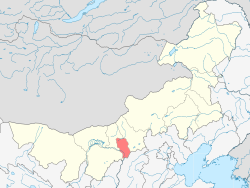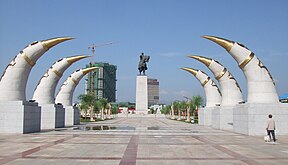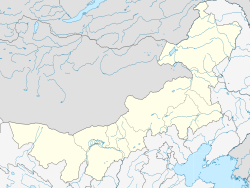Hohhot
呼和浩特市 · ᠬᠥᠬᠡᠬᠣᠲᠠ Huhehot, Kweisui, Kuei-sui | |
|---|---|
 | |
 Location of Hohhot City jurisdiction in Inner Mongolia | |
| Coordinates (Gongzhufu Park (公主府公园)): 40°50′05″N 111°39′23″E / 40.8346°N 111.6565°E | |
| Country | |
| Region | Inner Mongolia |
| County-level divisions | 10 |
| Township divisions | 116 |
| Established | 1580 |
| Municipal seat | Xincheng District |
| Government | |
| • Type | Prefecture-level city |
| • Body | Hohhot Municipal People's Congress |
| • CCP Secretary | Bao Gang |
| • Congress Chairman | Chang Peizhong |
| • Mayor | He Haidong |
| • CPPCC Chairman | Bai Yongping |
| Area | |
| • Prefecture-level city | 17,186.1 km2 (6,635.6 sq mi) |
| • Urban | 2,065.1 km2 (797.3 sq mi) |
| • Metro | 4,830.1 km2 (1,864.9 sq mi) |
| Elevation | 1,065 m (3,494 ft) |
| Population (2020 census)[2] | |
| • Prefecture-level city | 3,446,100 |
| • Density | 200/km2 (520/sq mi) |
| • Urban | 2,681,758 |
| • Urban density | 1,300/km2 (3,400/sq mi) |
| • Metro | 2,944,889 |
| • Metro density | 610/km2 (1,600/sq mi) |
| • Major ethnic groups | |
| GDP[3] | |
| • Prefecture-level city | CN¥ 309.1 billion US$ 49.6 billion |
| • Per capita | CN¥ 101,492 US$ 16,295 |
| Time zone | UTC+08:00 (China Standard) |
| Postal code | 010000 |
| Area code | 471 |
| ISO 3166 code | CN-NM-01 |
| License plate prefixes | 蒙A |
| Local Dialect | Jin: Zhangjiakou-Hohhot dialect; Southern Mongolian |
| Administrative division code | 150100 |
| Website | www.huhhot.gov.cn |
Hohhot,[a] formerly known as Kweisui,[b] is the capital of Inner Mongolia in the north of the People's Republic of China,[5][6] serving as the region's administrative, economic and cultural center.[7] Its population was 3,446,100 inhabitants as of the 2020 census, of whom 2,944,889 lived in the metropolitan area consisting of 4 urban districts (including Hohhot Economic and Development Zone) plus the Tümed Left Banner.[8]
The name of the city in Mongolian means "Blue City", although it is also wrongly referred to as the "Green City."[9] The color blue in Mongol culture is associated with the sky, eternity and purity. In Chinese, the name can be translated as Qīng Chéng (Chinese: 青城; lit. 'Blue/Green City')[10] The name has also been variously romanized as Kokotan, Kokutan, Kuku-hoton, Huhohaot'e, Huhehot, Huhhot, Huhot, or Köke qota.[6]
The city is a seat of the Inner Mongolia University, the largest regional comprehensive university and the only 211 Project University in Inner Mongolia.
- ^ Ministry of Housing and Urban-Rural Development, ed. (2019). China Urban Construction Statistical Yearbook 2017. Beijing: China Statistics Press. p. 48. Archived from the original on 18 June 2019. Retrieved 11 January 2020.
- ^ "Nèi Mĕnggŭ / Inner Mongolia (China): Prefectural Division & Major Cities – Population Statistics, Maps, Charts, Weather and Web Information".
- ^ 内蒙古自治区统计局、国家统计局内蒙古调查总队 (2016). 《内蒙古统计年鉴-2016》. 中国统计出版社. ISBN 978-7-5037-7901-5.
- ^ "Hohhot". Lexico UK English Dictionary. Oxford University Press. Archived from the original on 18 May 2021.
- ^ "Illuminating China's Provinces, Municipalities and Autonomous Regions". PRC Central Government Official Website. 2001. Retrieved 28 May 2014.
- ^ a b Solovʹev, Sergeĭ Mikhaĭlovich (1998), History of Russia, vol. 23, Academic International Press, p. 178, ISBN 9780875691930
- ^ The New Encyclopædia Britannica, 15th Edition (1977), Vol. I, p. 275.
- ^ Wang, Tong (王彤). 呼和浩特市2010年第六次全国人口普查主要数据. 内蒙古日报 [Inner Mongolia Post]. Retrieved 13 July 2015 – via Inner Mongolia News.
- ^ Perkins (1999), p. 212.
- ^ Chinese "qing" has traditionally been a color between "blue" and "green" in English, leading some modern sources to translate Qing Cheng into English as "Green City" instead of "Blue City," including, for example, the official website of Hohhot Archived 15 May 2009 at the Wayback Machine.
Cite error: There are <ref group=lower-alpha> tags or {{efn}} templates on this page, but the references will not show without a {{reflist|group=lower-alpha}} template or {{notelist}} template (see the help page).









